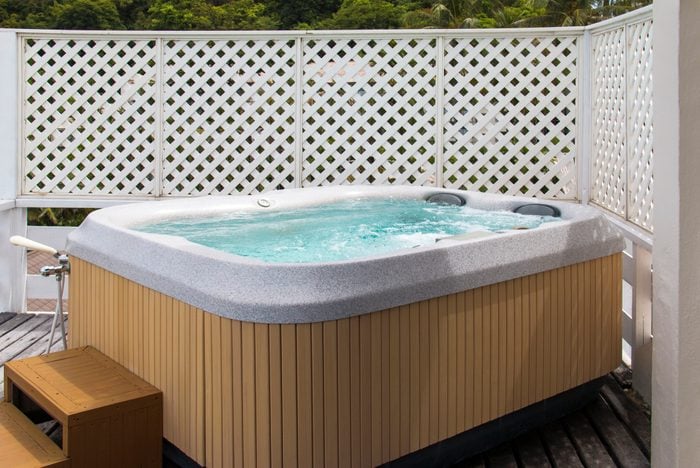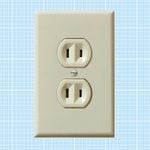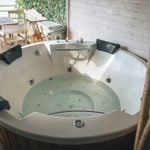Outdoor Hot Tub Wiring Tips

If you're considering installing the wiring for an outdoor hot tub, we're here to help you understand the scope of the project.
Our editors and experts handpick every product we feature. We may earn a commission from your purchases.
Homeowners everywhere are renovating backyard spaces so they can make the most of their time outdoors. If an outdoor hot tub is in your plans, here are some tips to ensure you wire it correctly. For those with an indoor hot tub, worry not. Here’s how you can handle your hot tub’s wiring. As always, safety first, so make sure you’re confident in your wiring skills before taking on this project.
Before You Start Your Outdoor Hot Tub Wiring Project
First things first. Be sure to consider:
Type of hot tub
There are different types of outdoor hot tubs (aka spas), and the National Electrical Code (NEC) has different rules for different types. Here, we’re talking specifically about self-contained hot tubs.
The hot tub should include a label indicating it’s approved for outdoor, above-ground use. This type of hot tub is a manufactured unit that includes the tub vessel, water pumps, water heaters and control equipment, all entirely under the skirt of the hot tub.
Hot tub safety certification
When purchasing a hot tub or spa, be sure it’s certified and labeled by a nationally recognized testing laboratory like UL, ETL, CSA, MET or another accredited product evaluation and certification organization.
Location
To safely enjoy your hot tub, receptacle outlets, lighting and other electrical apparatus must be out of reach of people in the tub.
Self-contained hot tubs feature a removable panel for access to the main electrical control panel, water pumps and other equipment within the skirting. Make sure there’s at least 36 inches of permanent working space in front of the access panel for the safety of anyone servicing the tub.
No overhead power or communication cables of any kind are permitted above the hot tub.
Electrical capacity
A hot tub uses a lot of power for its water heaters and pumps. This usually requires a dedicated branch circuit rated at 120/240 volts, and anywhere from 30 to 50 amperes.
Electrical connection
Have a plan for making the electrical connection to the hot tub. Self-contained tubs may be cord connected, convertible or permanently wired.
A convertible hot tub comes from the factory with a power-supply cord but may be field-converted for a permanent connection. If your hot tub will be permanently wired, you might be able to pre-install most of the wiring before delivery.
Permits and inspections
Whether you install the wiring yourself or hire a licensed electrical contractor, your local building inspection office will require permits and inspections. An electrical inspection is the most affordable insurance you can buy!
Gather Tools and Materials
Save time and frustration by having these items on hand before you start the installation:
Tools
- Hearing protection, safety glasses, work gloves and sturdy footwear.
- Combination square, wood folding ruler and measuring tape.
- Digging tools — garden shovel, drain shovel, trench shovel, pick mattock, etc.
- Cordless drill, along with drill, driver and hole-saw bits.
- Hacksaw and hammer.
- Electrician’s diagonal and side cutting pliers, along with tongue-and-groove pipe pliers.
- Digital multimeter and noncontact voltage sniffer.
- Screwdrivers, torpedo level, utility knife and wire strippers.
Materials
The nameplate on your hot tub will display the voltage and amperage requirements. These dictate the size of circuit breakers, cables and wires, conduits and other electrical materials.
Your existing main service panel will dictate the type and style of the feeder circuit breaker. Other conditions at your home will also impact the installation. Before you start, gather these material:
- Outdoor hot tub maintenance disconnect switch with factory-installed GFCI protection.
- Four-wire Type SER aluminum service-entrance cable (two hots, one neutral, one equipment grounding wire).
- Two-pole, 240-volt feeder breaker for the main service panel.
- One-inch Schedule 80 PVC conduit and fittings.
- #6 AWG copper insulated wire (black, red, white and green).
Outdoor Hot Tub Wiring Checklist
Make a checklist to guide you through the process:
- Gather all of the necessary materials and tools.
- Turn off the MAIN breaker at your service panel.
- Put on safety glasses, work gloves and sturdy footwear and carefully remove the cover from your service panel.
- DANGER! The incoming wires from the electric utility meter will still be energized (hot).
- Install the hot tub feeder circuit breaker in any suitable vacant space in the service panel.
- From the hot tub feeder circuit breaker, install the Type SER cable from the service panel to the exterior wall of your home. Poke the cable out through a hole in the wall.
- Connect the Type SER cable to the back side of the hot tub disconnect switch, and mount it to the exterior wall. Caulk around the disconnect switch enclosure to seal out rain and snow.
- From the hot tub disconnect switch, run Schedule 80 PVC conduit to the hot tub.
- Insert four insulated copper wires into the PVC conduit (black, red, white and green).
- Terminate the insulated wires at both ends, inside the hot tub control box and inside the hot tub disconnect switch.
- Once all of the wires have been terminated and the wiring is safe to be energized, turn on the feeder circuit breaker at the service panel and the GFCI circuit breaker at the hot tub disconnect switch.
- Use your voltage tester to check for proper voltages. If everything is good, test the hot tub.
Outdoor Hot Tub Wiring Reminders
Keep these things in mind before wiring your outdoor hot tub:
- In addition to the National Electrical Code (NEC), the hot tub manufacturer’s installation instructions must be followed.
- A maintenance disconnecting means (switch) must be installed to allow service personnel to turn off power to the hot tub.
- The maintenance disconnecting means must be readily accessible, within sight of the tub, and at least five feet from the inside walls of the hot tub.
- Self-contained outdoor hot tubs generally require a four-wire branch circuit with two hot conductors, a neutral conductor and an equipment grounding conductor.
- Hot tubs require ground-fault circuit-interrupter protection (GFCI).
- Check the manufacturer’s installation instructions to see if copper wire is required for the connection to the hot tub control panel. (Aluminum wiring is not allowed.)
- At least one general-purpose 15- or 20-ampere GFCI-protected receptacle outlet must be provided for maintenance. It must be not less than six feet and not more than 20 feet from the inside wall of the tub.
- Other receptacles in the area must be at least six feet, measured horizontally, from the inside walls of the tub.
- ALL receptacles rated 120 volts and within 20 feet of the inside walls must be GFCI protected.
- Light fixtures, lighting outlets and ceiling-suspended paddle fans over the hot tub or within five feet measured horizontally must be installed at least 12 feet above the maximum water level.
- Light switches must be at least five feet, measured horizontally, from the inside walls of the hot tub.



